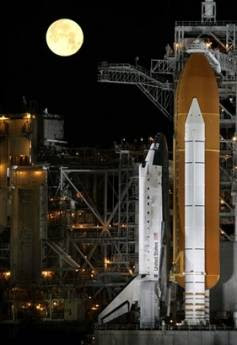Okay, no more posts about horrible music... moving on! I hate that this is all in the past tense now, but...
The United Space Alliance (USA) built six space shuttle OVs, or "Orbital Vehicles": Enterprise (1976), Columbia (1981), Challenger (1983), Discovery (1984), Atlantis (1985), and Endeavour (1992).
Space Shuttle Enterprise alone never launched, as it was air-worthy as a tester, but not deemed space worthy after certain design changes. For many moons she has rested at the Smithsonian, but will move soon to New York so Shuttle Discovery can take her place!

My favorite portrait of Discovery
The space shuttles could move at about 17,500 miles per hour, or roughly 25 times the speed of sound.
To put this number in perspective, it takes the average Boeing jet about 5-6 hours to fly from San Francisco to New York. A Space Transportation System (STS) could cut the trip to 9 minutes.
Astronauts Jan Davis and Mark Lee, who flew aboard Space Shuttle Endeavour in September 1992, were the first (and still only) married couple to travel into space together.
Conditions permitting, returning shuttles landed at Kennedy Space Center, but if alternatives were needed either for a landing or "launch abort," shuttles could land at various commercial and military sites in 25 states and 33 different countries.

My favorite portrait of Atlantis
Together, the space shuttle orbiter, external tank and twin solid rocket boosters had approximately 2,506,450 parts.
The US is not the only nation to build a "re-usable" spacecraft. While many of us are saddened that the Shuttle program ended... hey, we still had one for 30 years!
In 1976, the USSR created three Буран ("Blizzard") crafts; the first was scrapped, but the second completed an unmanned spaceflight in 1988. The Soviets subsequently cancelled their shuttle program in 1993 and the active Buran was unexpectedly destroyed in 2002 when the roof of its hangar collapsed under heavy snow. The third Buran is on display at Technikmuseum Speyer (Germany).


































































